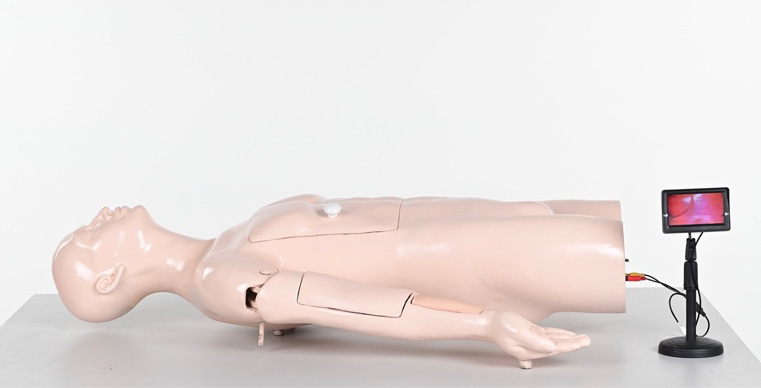Development of Simulation Model for Transradial Catheterization Practice for Physicians
DOI:
https://doi.org/10.33192/Smj.2022.68Keywords:
Transradial catheterization, medical simulation model, silicone rubberAbstract
Objective: This study tested different types of silicone rubber material to assess the most durable with properties that best simulated the human skin and vascular. The optimal materials were used to produce a transradial catheterization simulation model to train medical practitioners and tested the improvement of the training with a medical simulation model.
Materials and Methods: Three types of silicone rubber were tested for their suitability as artificial skin and vascular for transradial catheterization simulation model. Eighteen fellowship physicians assessed the simulator’s operational effectiveness and recorded their satisfaction with the training.
Results: Silicone rubbers were tested for realism and capability for repetitive training. Silicone rubber RTV-01 was the most durable for simulating the artificial skin, while silicone rubber RTV-03 was the most durable for simulating the artificial vascular with statistically significant results recorded by Kaplan-Meier analysis (P < 0.1). Satisfaction assessment results of the 18 participants using a Likert scale (5 points) returned total average scores of model’s efficacies as 4.41 and total average scores of model’s usefulness as 4.59.
Conclusion: The materials were used for transradial catheterization simulation to enhance fellowship trainees’ learning efficiency through practice. The fellowship trainees became familiar with the equipment, gained a higher completion rate, and increased confidence in treatment planning.
References
healthdata.org. What causes the most deaths [Internet]. 2017 [cited 2020 Jun 4]. Available from: http://www.healthdata.org/thailand
Gomes BR. Care of the Patient Undergoing Radial Approach Heart Catheterization: Implications for Medical-Surgical Nurses. Medsurg Nurs. 2015;24(3):173-6.
Mason PJ, Shah B, Tamis-Holland JE, Bittl JA, Cohen MG, Safirstein J, et al. An Update on Radial Artery Access and Best Practices for Transradial Coronary Angiography and Intervention in Acute Coronary Syndrome: A Scientific Statement From the American Heart Association. Circ Cardiovasc Interv. 2018;11:e000035
Truesdell AG, Delgado GA, Blakeley SW, Bachinsky WB. Transradial peripheral vascular intervention: challenges and opportunities. Interventional Cardiology. 2015;7(1):55-76.
Qurash MT, Yaacob NY, Azuan N, Khaleel YS, Zakaria R. Special Ultrasound Phantom for Interventional Training: Construction, Advantages, and Application. J Med Ultrasound 2018;26:210-4.
Lertbunnaphong T, Simulation Based Medical Education). Siriraj Med Bull [Internet]. 2017 Mar 30 [cited 2022 Mar 21];8(1):39-46.
Lin-Martore M, Kant S, Bridget C. O’Brien. Procedural skill maintenance: Perspectives and motivations of pediatric emergency medicine faculty. AEM Education and Training 2021;5:4. Available from: https://doi.org/10.1002/aet2.10696
Davidson LJ, Chow KY, Jivan A, Prenner SB, Cohen ER, Schimmel DR, et al. Improving cardiology fellow education of right heart catheterization using a simulation-based curriculum. Catheter Cardiovasc Interv. 2021;97(3):503-8.
Prenner SB, Wayne DB, Sweis RN, Cohen ER, Feinglass JM , Schimmel DR. Simulation‐based education leads to decreased use of fluoroscopy in diagnostic coronary angiography. Catheter Cardiovasc Interv. 2018;91(6):1054-9.
Gauthier N, Johnson C, Stadnick E, Keenan M, Wood T, Sostok M, et al. Does Cardiac Physical Exam Teaching Using a Cardiac Simulator Improve Medical Students’ Diagnostic Skills? Cureus. 2019;11(5):e4610.
Burton R, Hope A. Simulation-based education and expansive learning in health professional education: a discussion. J Appl Learn Teach. 2018;1(1):25-34.
Aggarwal R, Mytton OT, Derbrew M, Hananel D, Heydenburg M, Issenberg B, et al. Training and simulation for patient safety. Qual Saf Health Care. 2010;19(Suppl 2):i34-43.
Sørensen JL, Østergaard D, LeBlanc V, Ottesen B, Konge L, Dieckmann P, et al. Design of simulation-based medical education and advantages and disadvantages of in situ simulation versus off-site simulation. BMC Med Educ. 2017;17(1):20.
Sagalowsky ST, Wynter SA, Auerbach M, Pusic MV, Kessler DO. Simulation-based procedural skills training in pediatric emergency medicine. Clin Pediatr Emerg Med. 2016;17(3):169-78.
Mehdi Z, Ross A, Reedy G, Roots A, Ernst T, Jaye P, Birns J. Simulation training for geriatric medicine. Clin Teach. 2014;11:387-92.
Ngamchaliew P, Vichitkunakorn P, Wangsapan P, Buppodom N, Junchoo N, Chanhom P, et al. Innovative Device for Enhancing Physical Distancing in the COVID-19 Situation. Siriraj Med J. 2021;73(2):69-76.
Wongwandee M, Paritakul P. Pre-class versus In-class Video Lectures for the Flipped Classroom in Medical Education: A Non-randomized Controlled Trial. Siriraj Med J. 2020;72(6):476-82.
Barsuk JH, McGaghie WC, Cohen ER, O’Leary KJ, Wayne DB. Simulation-based mastery learning reduces complications during central venous catheter insertion in a medical intensive care unit. Crit Care Med. 2009;37(10):2697-701.
Schimmel DR, Sweis R, Cohen ER, Davidson C, Wayne DB. Targeting clinical outcomes: Endovascular simulation improves diagnostic coronary angiography skills. Wiley Online Library. 2015;87:383-8.
Zimmermann JM, Steffen OJ, Vicentini L, Daners MS, Taramasso M, Maisano F, et al. Novel augmented physical simulator for the training of transcatheter cardiovascular interventions. Catheter Cardiovasc Interv. 2020;95(6):1202-9.
simbionix.com. ANGIO MENTOR PLATFORMS [Internet].2017 [cited 2020 Jun 4]. Available from: https://simbionix.com/simulators/angio-mentor/platforms/
See KWM, Chui KH, Chan WH, Wong KC, Chan YC. Evidence for Endovascular Simulation Training: A Systematic Review. Eur J Vasc Endovasc Surg. 2016; 51(3):441-51.
Patterson MD, Geis GL, Falcone RA, LeMaster T, Wears RL. In situ simulation: detection of safety threats and teamwork training in a high risk emergency department. BMJ Qual Saf. 2013;22(6):468-77.
Muthu Joseph E.R.P. Mechanics of silicon micro needle penetration in human cadaver skin and skin substitutes. (2007). Theses and Dissertations. 972. Available from: https://preserve.lib.lehigh.edu/islandora/object/preserve%3Abp-3101547
Brick in The Yard Mold Supply. (2018, February 11). RTV Silicone Tutorial: Shore A Scale [Video file]. Available from: https://www.youtube.com/watch?v=Oj9fwv6BcUM&list=PLOuHAOXIwWkMRRvtmovrWu-nBGIVRIenj&index=15

Published
How to Cite
Issue
Section
License

This work is licensed under a Creative Commons Attribution-NonCommercial-NoDerivatives 4.0 International License.
Authors who publish with this journal agree to the following conditions:
Copyright Transfer
In submitting a manuscript, the authors acknowledge that the work will become the copyrighted property of Siriraj Medical Journal upon publication.
License
Articles are licensed under a Creative Commons Attribution-NonCommercial-NoDerivatives 4.0 International License (CC BY-NC-ND 4.0). This license allows for the sharing of the work for non-commercial purposes with proper attribution to the authors and the journal. However, it does not permit modifications or the creation of derivative works.
Sharing and Access
Authors are encouraged to share their article on their personal or institutional websites and through other non-commercial platforms. Doing so can increase readership and citations.














